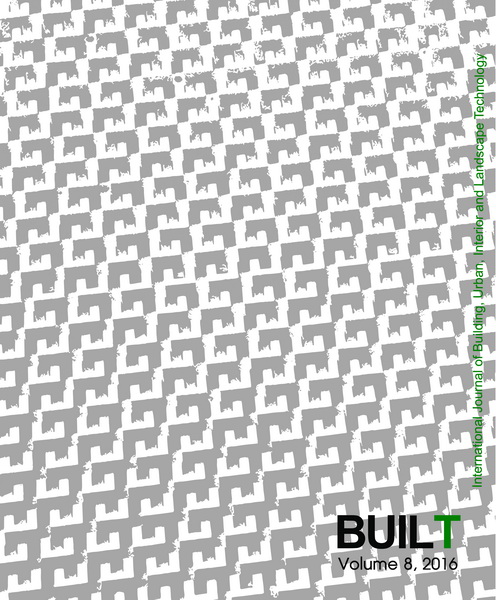Vanishing Traditional Vernacular Dwelling in Gully Region of Loess Plateau, China
Keywords:
Loess Plateau, Gully regions, Vernacular dwelling, Development situation, New countryside constructionAbstract
Gully region of Loess Plateau is one of the subtype regions and natural geographical units in Loess Plateau. Due to the backward economy and fragile ecology, the development of rural area restr ained and even contracted for a long time. Since the implementation of construction of new socialist countryside in 2005, this region has developed amazingly. However, lack of ecological and sustainable development theory as the guideline, lots of new vernacular dwellings just pursuit construction speed and the convenience of operation, and simply copy the urban construction model, which cause the separation of rural habitats construction with regional characteristics. Based on the field investigation, this paper analyzes the development tendency of vernacular dwellings in gully region of Loess Plateau and construction situation of the newly built vernacular dwellings. Then, it summarizes the problems of vernacular dwellings during the new countryside construction. Finally, the paper analyzes the reasons of the problem. The results of this research can make up the gaps exited in the construction of new countryside, which hopes to be uses as reference in the future ecological and sustainable construction of vernacular dwellings in gully regions of Loess Plateau.
Downloads
References
Chen, Z. H. (1999). Essay about architecture. China: He Nan Technology press.
Huang, Y. W. (2014). When architects meet craftsmen. Journal of architecture, 3, 21-22.
Ke, M. & Wang, C. Y. (2013). Research on energy-saving strategy of the rural vernacular dwellings in northwest China. Industrial Construction, 4, 12.
Li, G. S. (1989). Research on the division of semi humid and semi dry area. Geographical society, 21, 111-123.
Li, J. Q. (2009). Research and model for socialist new rural construction. Haidian Qu, China: Chinese Academy of Agricultural Sciences.
Li, Y. B. (2008). Ecological experience of traditional vernacular dwellings and its application. Shi, China: Tianjin University.
Liang, R., Zhang, Q. & Liu, J. P. (2010). Strategy research on the ecological design of vernacular dwellings in the Chinese west northern areas under the restrain of local conditions. Journal of Xi’an University of Architecture and Technology, 42(4), 585-587.
Lu, Y., Li, C. R. & Yu, J. W. (2013). Wind direction and speed outside the green architecture, Architectural technology. Architectural technology, 5, 15-16.
Loess Plateau comprehensive scientific expedition Academy of Sciences. (1990). Division of Comprehensive Management Development in the Loess Plateau. Beijing: China Economic Publishing House.
Ma, H. & Liu, J. P. (2010). Research on the climate suitability of vernacular dwellings in Chinese western countryside. Architectural energy saving, 6, 54-58.
Xu, X. Y. (2007). Research on traditional vernacular dwellings in the north of Wei River of Loess Plateau. ShangQuan China: Xi’an University of Architecture and Technology.
Yu, H. X. (2007). Research on the ecological theory and planning design methods in gully region of Loess Plateau. Xian: Xi’an University of Architecture and Technology.
Yunxia, W. X. W. (2007). Developing with inheriting—— Attempt of modernization in traditional folk house in Guanzhong zone. Huazhong Architecture, 5, 42.
Zhang, T. Z. (1993). Outline of Loess Plateau. Beijing: Chinese Environmental and Scientific press.
Zhao, Q. & Liu, J. P. (2003). Sustenance and development of architectural culture with regional characteristics ——brief illustration on sustainable development of traditional vernacular dwellings. New Architecture, 2, 24-25.
Zhao, Q. (2004). Ecological construction of traditional vernacular dwellings. ShangQuan China: Xi’an University of Architecture and Technology.
Zhao, X. P., Hu, H. B. & Liu, J. P. (2006). Evaluation on environmental suitability of traditional vernacular dwellings. Journal of Xi’an University of Science and Technology, 3, 335-337.
Zhou, Q. H. (2006). The evolution of the structure of cities and towns in Loess Plateau in the north of Shaanxi province, and their space forms. City planning, 39-43.
Zhou, R. Q. (2007). Green architectural system and human settlements models in Loess Plateau. China: Beijing Architectural and building press.
Downloads
Published
How to Cite
Issue
Section
License

This work is licensed under a Creative Commons Attribution-NonCommercial-NoDerivatives 4.0 International License.












